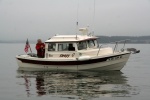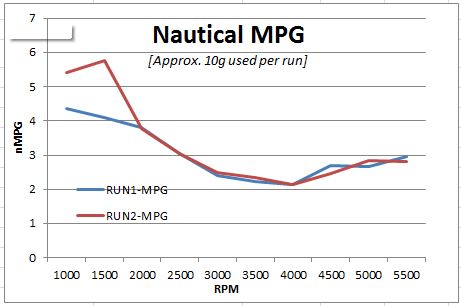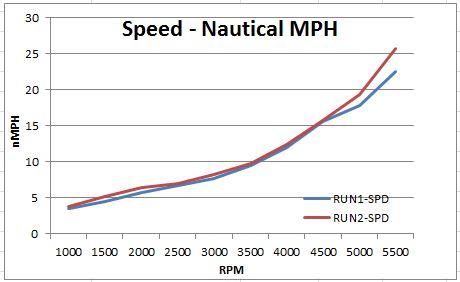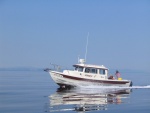| View previous topic :: View next topic |
| Author |
Message |
seagrits@aol.com
Joined: 20 Aug 2020
Posts: 9
City/Region: Ridgeland, South Carolina
State or Province: SC
|
 Posted: Mon Nov 23, 2020 8:32 am Post subject: Fuel consumption Posted: Mon Nov 23, 2020 8:32 am Post subject: Fuel consumption |
 |
|
Fuel consumption....
Evening folks... just got back from a 3 day cruise on our 22. Total milage for the trip was 172 miles, and did some testing while out.
Twin 50 hp Hondas, carbureted
Rpm. Speed
2000. 7.1 mph
2500. 8.5 mph
3000. no data
3500. 13 mph
4000. 17.5 mph
4500. 20 mph
Using this sight for fuel consumption (granted they are now fuel injected) https://www.boat-fuel-economy.com/honda-outboard-fuel-consumption-us-gallons
I calculated my fuel consumption and was quite surprised.
Rpm. Speed. Burn/hr(site) fuel economy
2000. 7.1 mph. .7. 10.14 mpg
2500. 8.5 mph. 1. 8.5 mpg
3000. no data. 1.3
3500. 13 mph. 1.5. 8.6 mph
4000. 17.5 mph. 1.6. 10.9 mpg
4500. 20 mph. 2.0. 10.0 mpg
Now the final tally would be devided by 2 because of twins, but I was amazed how ducking along at 7.1 mph gives comparable performance as 20 mph.
Are any of you experiencing similar numbers?
Many thanks. |
|
| Back to top |
|
 |
colbysmith
Joined: 02 Oct 2011
Posts: 4545
City/Region: Madison
State or Province: WI
C-Dory Year: 2009
C-Dory Model: 25 Cruiser
Vessel Name: C-Traveler
Photos: C-Traveler and Midnight-Flyer
|
 Posted: Mon Nov 23, 2020 11:03 am Post subject: Posted: Mon Nov 23, 2020 11:03 am Post subject: |
 |
|
| I think a better observation would be, how much total fuel did you burn in that 172 mi? (And for clarification, was that statute or nautical?) I have found on both my past 22 and on my current 25, fuel economy goes down at anything above hull speed. (About 5mph on the 22, and 6 mph on the 25.) A few mph above hull speed, your fuel economy will go down as you are pushing water. As you plane out the economy comes back some, but will never equal what it was at displacement speeds. More directly, on my 22 with the Merc 115 EFI 4 Stroke, at displacement speed of 5 mph, I would get about 5-6 gph, which equated to 5 mpg or slightly better. Those were actual numbers taken off of my engines fuel data readout. At planning speeds, on a normally loaded boat, I was getting about 3.1 mpg. (I forget my GPH readout, but I do remember the computation of 3.1). In Alaska a few years ago, loaded heavily, I was only getting around 2.9 mpg at planning speeds, but the 5-6mpg at displacement. On my new to me 25 with the Yamaha 150 4 stroke, I really haven't gotten a good feel for the fuel economy yet. But the displacement speeds seem to be on par with the 22, while on plane I think I'm somewhere in the upper 2's for mpg. Colby |
|
| Back to top |
|
 |
ssobol
Joined: 27 Oct 2012
Posts: 3370
City/Region: SW Michigan
State or Province: MI
C-Dory Year: 2008
C-Dory Model: 22 Cruiser
Vessel Name: SoBELLE
Photos: SoBelle
|
 Posted: Mon Nov 23, 2020 11:36 am Post subject: Posted: Mon Nov 23, 2020 11:36 am Post subject: |
 |
|
| On my 22 with a Honda BF90D, I've seen a noticeable drop in MPG when cruising and the engine switches modes about 4400 RPM. There is a change in the engine sound when this occurs if you are listening for it. However, once in the higher RPM range the mpg is pretty much constant for the entire speed range (>20 mph). |
|
| Back to top |
|
 |
thataway
Joined: 02 Nov 2003
Posts: 20803
City/Region: Pensacola
State or Province: FL
C-Dory Year: 2007
C-Dory Model: 25 Cruiser
Vessel Name: thataway
Photos: Thataway
|
 Posted: Mon Nov 23, 2020 12:32 pm Post subject: Posted: Mon Nov 23, 2020 12:32 pm Post subject: |
 |
|
To know the real "economy" or MPG (Statute or nautical) you need flow meters. The "theoretical" does not take into effect many factors, including condition of bottom of boat, hull type, state of curve to planing speed, weight, prop size and slip, current, winds, sea surface state. etc...
I suspect if you were to either take the flow off computer or a flow meter, they would be considerably different. I tell you from experience with 22's various state of load and using flow meters.
_________________
Bob Austin
Thataway
Thataway (Ex Seaweed) 2007 25 C Dory May 2018 to Oct. 2021
Thisaway 2006 22' CDory November 2011 to May 2018
Caracal 18 140 Suzuki 2007 to present
Thataway TomCat 255 150 Suzukis June 2006 thru August 2011
C Pelican; 1992, 22 Cruiser, 2002 thru 2006
Frequent Sea; 2003 C D 25, 2007 thru 2009
KA6PKB
Home port: Pensacola FL |
|
| Back to top |
|
 |
T.R. Bauer
Joined: 17 Nov 2007
Posts: 1726
City/Region: Wasilla
State or Province: AK
C-Dory Year: 1993
C-Dory Model: 22 Cruiser
Vessel Name: C-Whisperer
|
 Posted: Mon Nov 23, 2020 1:40 pm Post subject: Posted: Mon Nov 23, 2020 1:40 pm Post subject: |
 |
|
| I've had my 45s long enough to know they get 3-4 mpg cruising in decent seas with a pretty heavy load at 18-22 mph. If lightly loaded at the same speed, it gets 4-5 mpg. I usual figure 3 mpg to be on the safe side and have some reserve left over. |
|
| Back to top |
|
 |
seagrits@aol.com
Joined: 20 Aug 2020
Posts: 9
City/Region: Ridgeland, South Carolina
State or Province: SC
|
 Posted: Mon Nov 23, 2020 7:54 pm Post subject: Posted: Mon Nov 23, 2020 7:54 pm Post subject: |
 |
|
Lots of good comments, thanks fellas.
I really wasn't interested in fuel consumption for the overall trip, but rather mpg @ any given rpm, within the confines of similar water conditions throughout the range.
Since hull speed on the 22 is only a tad above 5 mph, based on a lwl of 16.25 ft. It surely makes me wish I would have paid more attention to speed at the 1000 and 1500 rpm marks.
I suppose my interest for all of this, is not only efficiency, but a curiosity as well. Being retired, I'm finding that I enjoy gawking at the shorelines. One day for example, we didn't pull the hook until around 10 a.m.. heading up river, I spun the little 50's up to 2200 and stayed at that point for the following 6 hours, perfectly content on watching the wildlife.
These are fun little boats. A little tight for two old codgers in their 60's and the little 4 legged buddy of ours, but we do enjoy getting it out to explore.....
Thinking I'll start looking around for flow meters for these little girls. Thanks again
[img][/img] |
|
| Back to top |
|
 |
thataway
Joined: 02 Nov 2003
Posts: 20803
City/Region: Pensacola
State or Province: FL
C-Dory Year: 2007
C-Dory Model: 25 Cruiser
Vessel Name: thataway
Photos: Thataway
|
 Posted: Mon Nov 23, 2020 10:46 pm Post subject: Posted: Mon Nov 23, 2020 10:46 pm Post subject: |
 |
|
| Quote: | | Since hull speed on the 22 is only a tad above 5 mph, based on a lwl of 16.25 ft. It surely makes me wish I would have paid more attention to speed at the 1000 and 1500 rpm marks. |
I am not sure where you got the 16.25 feet LWL. I think that is a bit low--I came up with about 19.5 feet dropping perpendiculars from my 22's. You would have taken the sq root, and multiple x 1.34. (A figure which is dependent on hull form, before the wave making action of trying to"climb" over the bow wave, and come up onto a plane). This is arbitrarily called Max Hull speed. Using the 19.5, LWL you come up with 5.9 knots. The 25 (25" 5" LOA) would be very close to 6.3 knots..
The slower the boat goes, the more efficient it is (Miles per gallon). My C dory 25 approximate numbers (150 HP fuel injected Honda) at 1000 RPM goes about 3.6 knots and burns about 0.8 gal / hr or about 4.5 NMPG.
At 1500 RPM the speed is 4.9 knots and burns about 1 gallon an hour: 4.9 NMPG
2000 RPM the speed is 6 knots and 1.6 gal per. hour and 3. 8 nmpg
OK so why apparent error, it seems that the mpg are better at about 5 than at about 3.6 knots.? the flow meters are very inaccurate at very low flow rates.
If you really want to know the NMGG at very low speeds (Less than a gallon an hour) you have to use calibrated containers over time, or buy a non marine lab quality fuel flow meter which will measure low flow. The Marine units use a turbine with a magnet rotating in a coil--primitive , but reasonably effective above one gallon an hour...I find that once calibrated they seem the be repeatable.
Garmin coses about $150 for the sensor--and you have to have the NMEA 2000 background.
RayMarine: can be adapted with other brands (and that is what I have) integrated into the NMEA backbone.
Lawrance (simrad) are about $200 each, plus backbone costs.
I have had fuel flow sensors on most of my boats--mainly to be sure of range. |
|
| Back to top |
|
 |
hardee
Joined: 30 Oct 2006
Posts: 12632
City/Region: Sequim
State or Province: WA
C-Dory Year: 2005
C-Dory Model: 22 Cruiser
Vessel Name: Sleepy-C
Photos: SleepyC
|
 Posted: Tue Nov 24, 2020 3:52 am Post subject: Re: Fuel consumption Posted: Tue Nov 24, 2020 3:52 am Post subject: Re: Fuel consumption |
 |
|
| seagrits@aol.com wrote: | Fuel consumption....
Evening folks... just got back from a 3 day cruise on our 22. Total milage for the trip was 172 miles, and did some testing while out.
Twin 50 hp Hondas, carbureted
Rpm. Speed
2000. 7.1 mph
2500. 8.5 mph
3000. no data
3500. 13 mph
4000. 17.5 mph
4500. 20 mph
Using this sight for fuel consumption (granted they are now fuel injected) https://www.boat-fuel-economy.com/honda-outboard-fuel-consumption-us-gallons
I calculated my fuel consumption and was quite surprised.
Rpm. Speed. Burn/hr(site) fuel economy
2000. 7.1 mph. .7. 10.14 mpg
2500. 8.5 mph. 1. 8.5 mpg
3000. no data. 1.3
3500. 13 mph. 1.5. 8.6 mph
4000. 17.5 mph. 1.6. 10.9 mpg
4500. 20 mph. 2.0. 10.0 mpg
Now the final tally would be devided by 2 because of twins, but I was amazed how ducking along at 7.1 mph gives comparable performance as 20 mph.
Are any of you experiencing similar numbers?
Many thanks. |
OK so you told us you were in a 22. Good, That is a start. Being interested in fuel economy is a good step, but there are some variables that need to be addressed. (And I am also concerned about fuel economy but, MPG? Not so much.) Oh, you say, and how can that be? Well, unless you are only boating on still water - lakes - miles per gallon is an inaccurate way to measure. (And I know there are plenty of folks here who think I am all wet, but . . . Oh well  ) )
First, if you are on a river, or ocean, the water is moving, relative to the ground, so, you could be sitting without the engines even running and be making miles per hour. That speed will affect your miles per gallon computation.
Second, how are you measuring the miles? As Colby mentioned, there are two kinds of miles statute or nautical. GPS miles will give you miles over the ground, and can be set for either, but you are (unless you are on that lake) on moving water, so your miles per gallon are distorted due to the water movement beneath you, either adding to or subtracting from your actual miles of movement.
Third, as you have noted in the above thread, slower is more economical, and slower is good: easier on the eyes, ears, back, knees and and billfold. You are retired, take the time to enjoy.
And, you are right, next to that slow cruise, about 4K RPM is a fairly efficient speed for the "gotta hurry and get there" times.
Harvey
SleepyC 

_________________
Though in our sleep we are not conscious of our activity or surroundings, we should not, in our wakefulness, be unconscious of our sleep. |
|
| Back to top |
|
 |
seagrits@aol.com
Joined: 20 Aug 2020
Posts: 9
City/Region: Ridgeland, South Carolina
State or Province: SC
|
 Posted: Tue Nov 24, 2020 6:15 am Post subject: Posted: Tue Nov 24, 2020 6:15 am Post subject: |
 |
|
Thanks thataway. The information you provided was what I was looking for. Regarding lwl, Colby stated hull speed for a 22 was roughly 5 mph. H.S. = 1.34 x √LWL is a general equation giving hull speed in knots, and doing a little reverse engineering is what put me at the 16.25 ft. Perhaps I'm wrong.
I realize there are always going to be physics involved when it comes to fuel consumption. However, is speed always inversely proportional to fuel economy? Clearly not. From hull speed to the moment just before plane, there is indeed a somewhat linear digression in fuel economy. Then all of a sudden, she pops out and starts riding on top of the water. I'm sure there is an intersecting line when calculating a fuel usage curve from stop to wot. The hull, as with all planing hulls, are bull dozens at anything above hull speed and at the moment of plane become ice skaters, where the engine, because of it's own torque and hp curve plus the lack of water resistance since on plane revert back to a more pleasant fuel consumption rate. As stated gentlemen, fuel consumption, and fuel economy are two entirely different entities, and its not an exact science, there are too many variables.
I think I'll go sit in a tree for a while....my head hurts after all this, and there's still room for one more deer in the freezer.....thanks again for all the feedback. |
|
| Back to top |
|
 |
Peter & Judy
Joined: 03 Dec 2014
Posts: 550
City/Region: Olds
State or Province: AB
C-Dory Year: 2005
C-Dory Model: 22 Cruiser
Vessel Name: Mistaya
Photos: Mistaya
|
 Posted: Tue Nov 24, 2020 3:45 pm Post subject: Posted: Tue Nov 24, 2020 3:45 pm Post subject: |
 |
|
I have played around with fuel consumption and cruising speed and keep good records and calculations in my pursuit of cruising range. I don't have fuel flow meter, but I make my calculations based on fuel fillings and tank levels. I record my distances on a GPS. My cruising varies from PNW salt water, to Canadian Lakes, to Lake Powell. So I am in a variety of conditions, different altitudes, fresh water, tides and currents, sea level and high altitude props etc. Mostly the boat is fairly heavy loaded and most of my trips are multi day. There are times that I just want to go somewhere around hull speed and other times that I want to be up on plane. I have only had the boat at WOT a couple of times and I don't enjoy this very much. I have a 22' Cruiser with a Honda 90 HP engine.
So my main determination was to find the two speeds that I am most comfortable with and where the boat handles best. I also considered fuel consumption at these speeds. Then to determine fuel consumption based on these. I am either going slow or fast, most trips are a combination of the two. My main goal after this is to have enough fuel for the trip that I am planning with some emergency reserve. Most of the time I come home with more fuel than I planned to. Because I am Canadian I do my calculations in litres and KM's when I am on fresh water, and litres and NM when I am on salt water and then convert from there. I do this the match the distance scales on the maps and charts that I use.
What I have found is that there are two sweet spots for RPM's and speed that I like to cruise at. For Hull Speed I am usually cruising at about 2200 to 2400 RPM, this gives me a speed of about 10 KMPH (6.2 MPH) +/- and then Planing Speed at about 4200 - 4400 RPM for about 20 - 22 KMPH (13-14 MPH). For my purposes I want to endure that I have enough fuel for my journeys especially when I go into northern waters where marinas and fuel docks are few and far between. At the above speeds the boat just feels right and handles well.
_________________
Peter & Judy Haase
Buffalo Horn Ranch
HMCB Mistaya
"Mistaya" (Grizzly Bear in Cree)
HMCB (Her Majesties Cute Boat) |
|
| Back to top |
|
 |
thataway
Joined: 02 Nov 2003
Posts: 20803
City/Region: Pensacola
State or Province: FL
C-Dory Year: 2007
C-Dory Model: 25 Cruiser
Vessel Name: thataway
Photos: Thataway
|
 Posted: Tue Nov 24, 2020 5:20 pm Post subject: Posted: Tue Nov 24, 2020 5:20 pm Post subject: |
 |
|
Here are the fuel curves on "Thataway" (ex Seaweed") The curves were done by a. previous owner. I have recalibrated the fuel flow meter, and the curves are very close. There are two separate curves --one into a slight current and one against. Note the difference in the low speeds--and the best "mileage" (in red) is against the current!!!.

The "real MPG at lowest speeds (Idle) is more, and between 1000 and 2000 is probably really somewhere between the red and blue curves above.

The transition from a displacement speed to the plane is very smooth and gradual in a flat bottom boat like the C Dory 22 and 25. It is a form which planes easily with low HP and quickly.
A deep V or even a catamaran is a much more radical change as one goes from semi displacement to.a full plane (depending on hull form). I have owned full displacement boats where if you put many times the max hp, the boat would never climb over the bow wave. It digs a deep hole. I owned one large sailboat boat where the option was a 90 or 120 hp diesel. The 120 hp had a max speed of about 0.2 knots more than the 90. The polar opposite is the Jon boat, or even the Carolina Skiff--all of the boat's bottom is essential flat with a little rocker--and they plane even a bit faster than the C Dory..But the Jon boat is very light and weight makes a huge difference.
This is all discussed very well in an excellent book by David Gerr "The Nature of Boats, Insights and Esoterica for the Nautically Obsessed". He discusses all types of boats including sailboats. The C Dory is in the very low end of the numbers: somewhere in the 2.5 x the sq root of waterline length to plane: So she is planing somewhere in the 10 to 11 knot range. A very low "hump" in the curve.
The deep V with a similar LWL may be in the 3.2 and not plane until 15 knots.
The big take away, is that the 1.34 (or 1.2 to 1.4) number x LWL is not an efficient speed number. It is the point where the boat begins to break free from the water. You don't really want to be in the area between this and the number where the boat begins to plane for best efficiency.
I have owned boats from 18 to 62 feet LOA which got 6 nautical miles per gallon at what seemed like a reasonable HP....It was always a relatively low HP--and in the larger boats was a Diesel engine (more efficient than the gas outboard). |
|
| Back to top |
|
 |
hardee
Joined: 30 Oct 2006
Posts: 12632
City/Region: Sequim
State or Province: WA
C-Dory Year: 2005
C-Dory Model: 22 Cruiser
Vessel Name: Sleepy-C
Photos: SleepyC
|
 Posted: Wed Nov 25, 2020 2:44 pm Post subject: Posted: Wed Nov 25, 2020 2:44 pm Post subject: |
 |
|
Peter and Judy said:
| Quote: | | "Mostly the boat is fairly heavy loaded and most of my trips are multi day. There are times that I just want to go somewhere around hull speed and other times that I want to be up on plane." |
I tend to think that is the way for many of us. It sure is for me. I tend to want to get across Juan de Fuca Strait ASAP so it will be up on plane at about 14 knots. For cruising in the islands, I tend to drop below that max hul speed of 5.? knots and run just below where the bow wave ripple is audible. I like the quiet -- hmmmmm, sounds like a sailer  still. Having twins, I have the option to shut one down and run on a single. to maintain the same speed, I have to bump up the RPM's so much of the time I run twins down, and a at a lower throttle speed. IIRC it is around 1500 RPM. Things are sure quiet there, and if I run that slow for long enough, I have to stop and take some fuel out of the tanks cause I get such good MPG still. Having twins, I have the option to shut one down and run on a single. to maintain the same speed, I have to bump up the RPM's so much of the time I run twins down, and a at a lower throttle speed. IIRC it is around 1500 RPM. Things are sure quiet there, and if I run that slow for long enough, I have to stop and take some fuel out of the tanks cause I get such good MPG 
Happy Thanksgiving to all.
Harvey
SleepyC 
 |
|
| Back to top |
|
 |
|
|
You cannot post new topics in this forum
You cannot reply to topics in this forum
You cannot edit your posts in this forum
You cannot delete your posts in this forum
You cannot vote in polls in this forum
You cannot attach files in this forum
You cannot download files in this forum
|
|

 Search
Search Private Messages
Private Messages Profile
Profile Log in
Log in Register
Register Help
Help





